Financial Management Report: Techniques and Sustainability
VerifiedAdded on 2023/01/10
|19
|4887
|77
Report
AI Summary
This report provides a comprehensive analysis of financial management, encompassing various aspects such as effective decision-making approaches, stakeholder management, and the significance of management accounting techniques. Scenario A explores formal and informal decision-making, investment decisions, and the application of techniques like brainstorming and cost-benefit analysis. It also addresses stakeholder management and the conflicting objectives of different stakeholders, along with techniques for fraud detection and prevention. Scenario B focuses on financial ratio analysis, the usefulness of data in decision-making, investment appraisal techniques, and the importance of financial decision-making for long-term sustainability. The report concludes with recommendations for improving financial sustainability and a reflection on the learning experience.
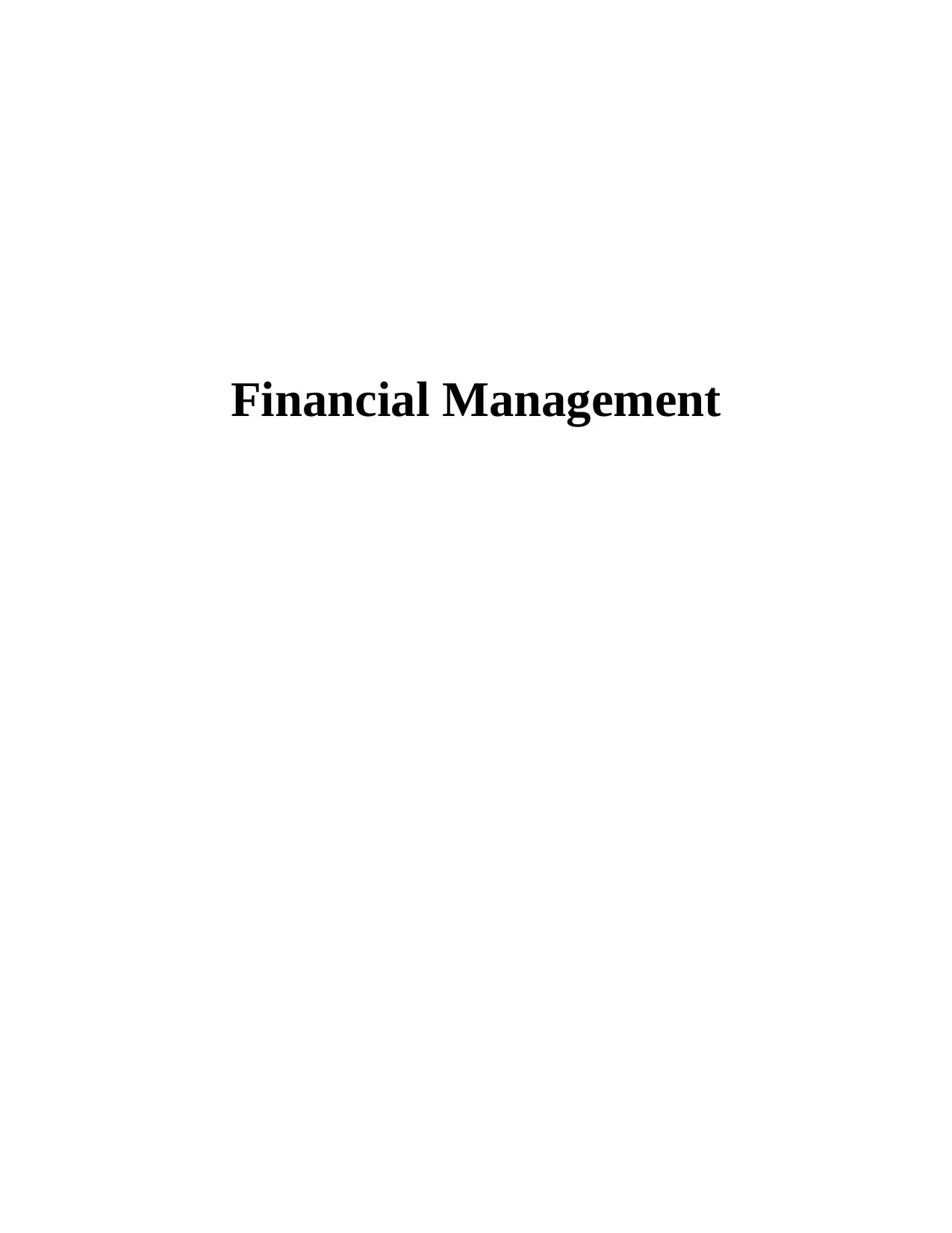
Financial Management
Paraphrase This Document
Need a fresh take? Get an instant paraphrase of this document with our AI Paraphraser
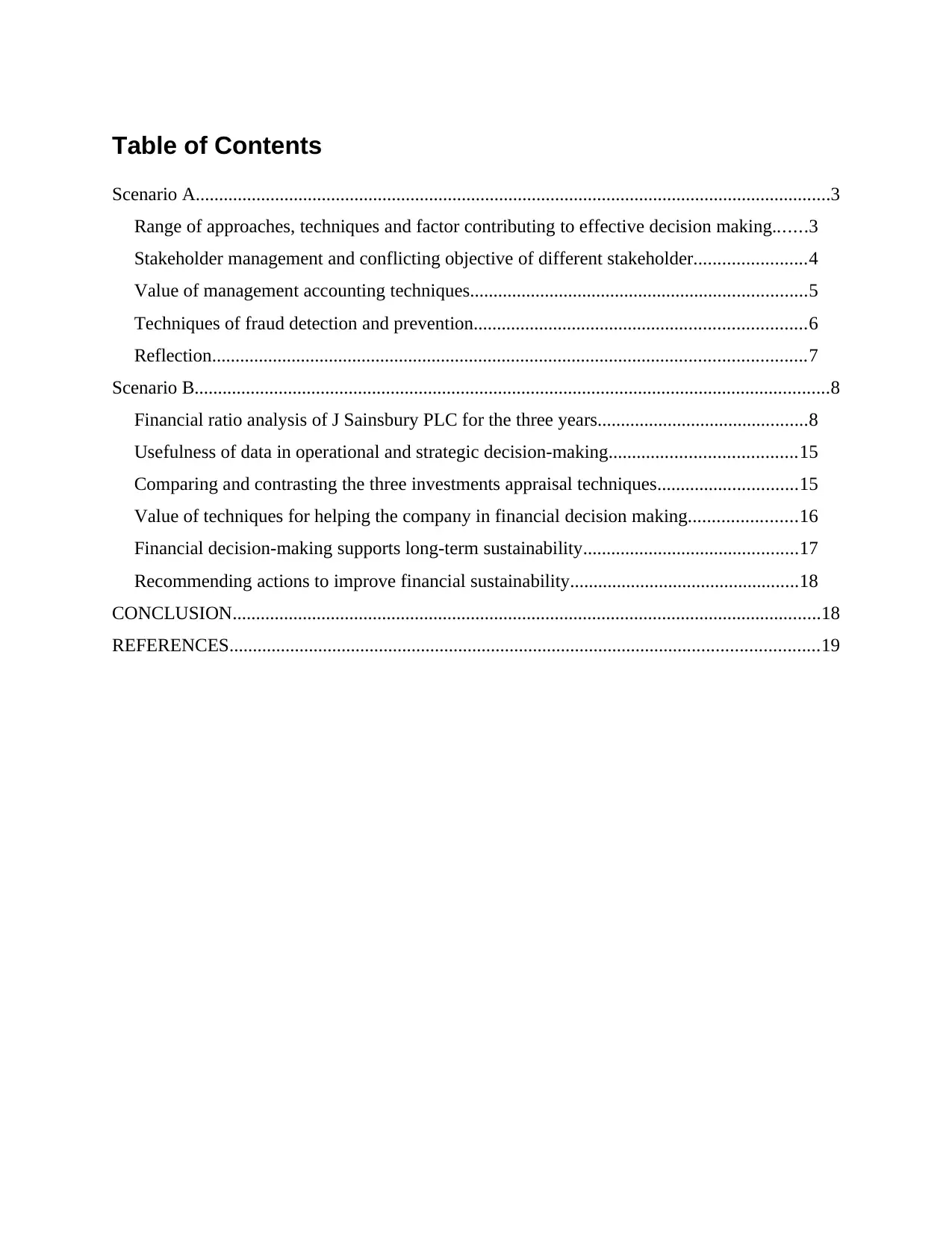
Table of Contents
Scenario A........................................................................................................................................3
Range of approaches, techniques and factor contributing to effective decision making.......3
Stakeholder management and conflicting objective of different stakeholder........................4
Value of management accounting techniques........................................................................5
Techniques of fraud detection and prevention.......................................................................6
Reflection...............................................................................................................................7
Scenario B........................................................................................................................................8
Financial ratio analysis of J Sainsbury PLC for the three years.............................................8
Usefulness of data in operational and strategic decision-making........................................15
Comparing and contrasting the three investments appraisal techniques..............................15
Value of techniques for helping the company in financial decision making.......................16
Financial decision-making supports long-term sustainability..............................................17
Recommending actions to improve financial sustainability.................................................18
CONCLUSION..............................................................................................................................18
REFERENCES..............................................................................................................................19
Scenario A........................................................................................................................................3
Range of approaches, techniques and factor contributing to effective decision making.......3
Stakeholder management and conflicting objective of different stakeholder........................4
Value of management accounting techniques........................................................................5
Techniques of fraud detection and prevention.......................................................................6
Reflection...............................................................................................................................7
Scenario B........................................................................................................................................8
Financial ratio analysis of J Sainsbury PLC for the three years.............................................8
Usefulness of data in operational and strategic decision-making........................................15
Comparing and contrasting the three investments appraisal techniques..............................15
Value of techniques for helping the company in financial decision making.......................16
Financial decision-making supports long-term sustainability..............................................17
Recommending actions to improve financial sustainability.................................................18
CONCLUSION..............................................................................................................................18
REFERENCES..............................................................................................................................19
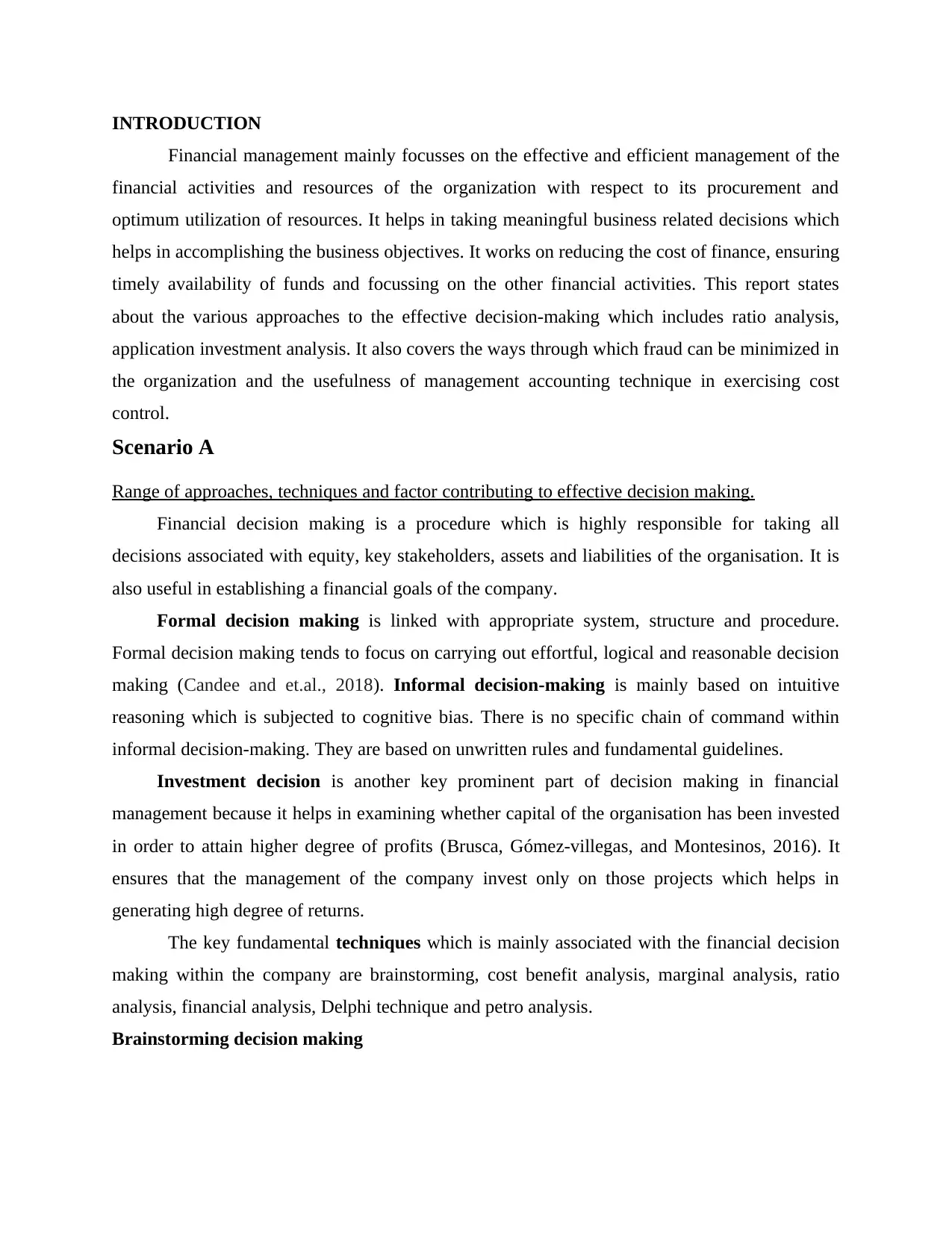
INTRODUCTION
Financial management mainly focusses on the effective and efficient management of the
financial activities and resources of the organization with respect to its procurement and
optimum utilization of resources. It helps in taking meaningful business related decisions which
helps in accomplishing the business objectives. It works on reducing the cost of finance, ensuring
timely availability of funds and focussing on the other financial activities. This report states
about the various approaches to the effective decision-making which includes ratio analysis,
application investment analysis. It also covers the ways through which fraud can be minimized in
the organization and the usefulness of management accounting technique in exercising cost
control.
Scenario A
Range of approaches, techniques and factor contributing to effective decision making.
Financial decision making is a procedure which is highly responsible for taking all
decisions associated with equity, key stakeholders, assets and liabilities of the organisation. It is
also useful in establishing a financial goals of the company.
Formal decision making is linked with appropriate system, structure and procedure.
Formal decision making tends to focus on carrying out effortful, logical and reasonable decision
making (Candee and et.al., 2018). Informal decision-making is mainly based on intuitive
reasoning which is subjected to cognitive bias. There is no specific chain of command within
informal decision-making. They are based on unwritten rules and fundamental guidelines.
Investment decision is another key prominent part of decision making in financial
management because it helps in examining whether capital of the organisation has been invested
in order to attain higher degree of profits (Brusca, Gómez‐villegas, and Montesinos, 2016). It
ensures that the management of the company invest only on those projects which helps in
generating high degree of returns.
The key fundamental techniques which is mainly associated with the financial decision
making within the company are brainstorming, cost benefit analysis, marginal analysis, ratio
analysis, financial analysis, Delphi technique and petro analysis.
Brainstorming decision making
Financial management mainly focusses on the effective and efficient management of the
financial activities and resources of the organization with respect to its procurement and
optimum utilization of resources. It helps in taking meaningful business related decisions which
helps in accomplishing the business objectives. It works on reducing the cost of finance, ensuring
timely availability of funds and focussing on the other financial activities. This report states
about the various approaches to the effective decision-making which includes ratio analysis,
application investment analysis. It also covers the ways through which fraud can be minimized in
the organization and the usefulness of management accounting technique in exercising cost
control.
Scenario A
Range of approaches, techniques and factor contributing to effective decision making.
Financial decision making is a procedure which is highly responsible for taking all
decisions associated with equity, key stakeholders, assets and liabilities of the organisation. It is
also useful in establishing a financial goals of the company.
Formal decision making is linked with appropriate system, structure and procedure.
Formal decision making tends to focus on carrying out effortful, logical and reasonable decision
making (Candee and et.al., 2018). Informal decision-making is mainly based on intuitive
reasoning which is subjected to cognitive bias. There is no specific chain of command within
informal decision-making. They are based on unwritten rules and fundamental guidelines.
Investment decision is another key prominent part of decision making in financial
management because it helps in examining whether capital of the organisation has been invested
in order to attain higher degree of profits (Brusca, Gómez‐villegas, and Montesinos, 2016). It
ensures that the management of the company invest only on those projects which helps in
generating high degree of returns.
The key fundamental techniques which is mainly associated with the financial decision
making within the company are brainstorming, cost benefit analysis, marginal analysis, ratio
analysis, financial analysis, Delphi technique and petro analysis.
Brainstorming decision making
⊘ This is a preview!⊘
Do you want full access?
Subscribe today to unlock all pages.

Trusted by 1+ million students worldwide
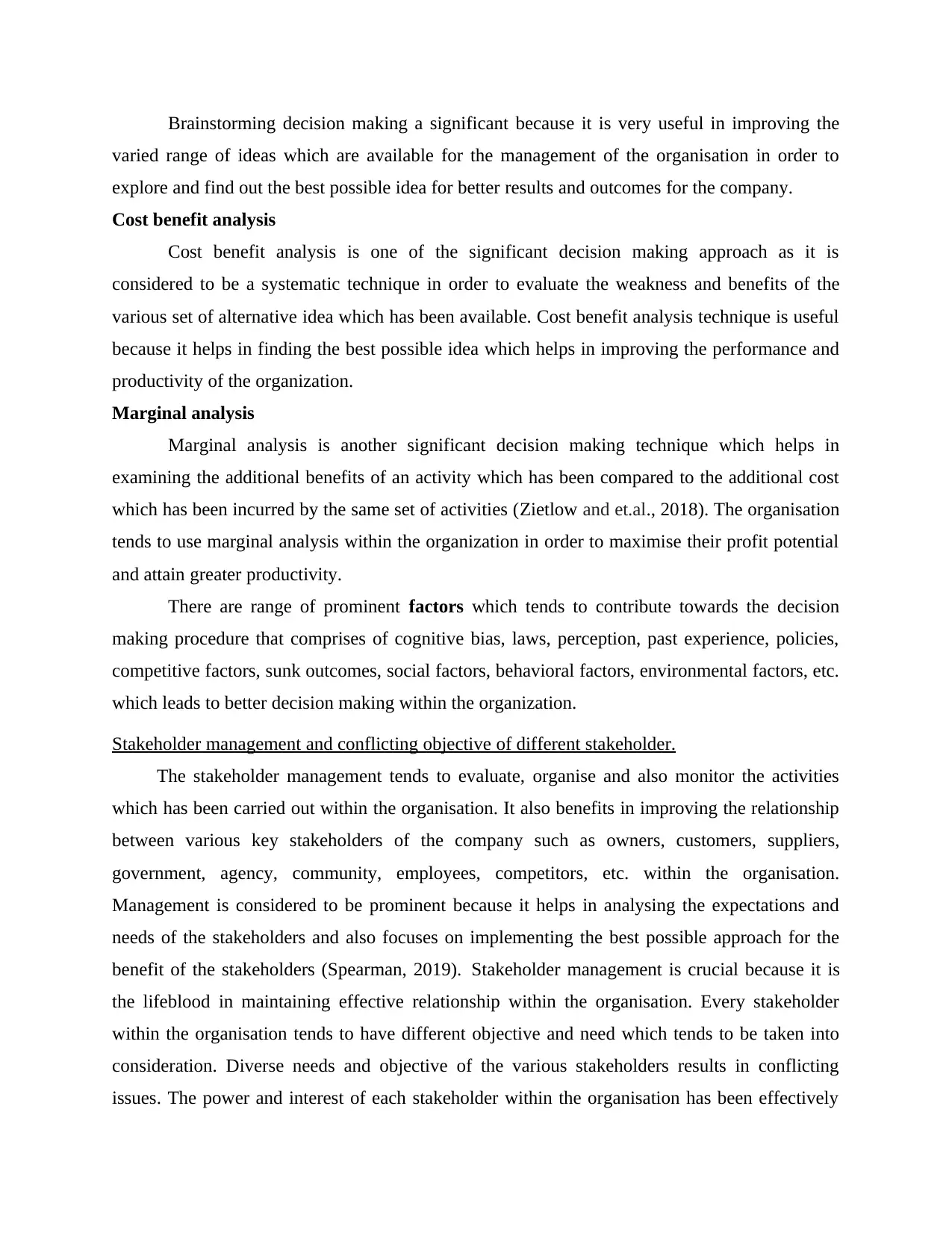
Brainstorming decision making a significant because it is very useful in improving the
varied range of ideas which are available for the management of the organisation in order to
explore and find out the best possible idea for better results and outcomes for the company.
Cost benefit analysis
Cost benefit analysis is one of the significant decision making approach as it is
considered to be a systematic technique in order to evaluate the weakness and benefits of the
various set of alternative idea which has been available. Cost benefit analysis technique is useful
because it helps in finding the best possible idea which helps in improving the performance and
productivity of the organization.
Marginal analysis
Marginal analysis is another significant decision making technique which helps in
examining the additional benefits of an activity which has been compared to the additional cost
which has been incurred by the same set of activities (Zietlow and et.al., 2018). The organisation
tends to use marginal analysis within the organization in order to maximise their profit potential
and attain greater productivity.
There are range of prominent factors which tends to contribute towards the decision
making procedure that comprises of cognitive bias, laws, perception, past experience, policies,
competitive factors, sunk outcomes, social factors, behavioral factors, environmental factors, etc.
which leads to better decision making within the organization.
Stakeholder management and conflicting objective of different stakeholder.
The stakeholder management tends to evaluate, organise and also monitor the activities
which has been carried out within the organisation. It also benefits in improving the relationship
between various key stakeholders of the company such as owners, customers, suppliers,
government, agency, community, employees, competitors, etc. within the organisation.
Management is considered to be prominent because it helps in analysing the expectations and
needs of the stakeholders and also focuses on implementing the best possible approach for the
benefit of the stakeholders (Spearman, 2019). Stakeholder management is crucial because it is
the lifeblood in maintaining effective relationship within the organisation. Every stakeholder
within the organisation tends to have different objective and need which tends to be taken into
consideration. Diverse needs and objective of the various stakeholders results in conflicting
issues. The power and interest of each stakeholder within the organisation has been effectively
varied range of ideas which are available for the management of the organisation in order to
explore and find out the best possible idea for better results and outcomes for the company.
Cost benefit analysis
Cost benefit analysis is one of the significant decision making approach as it is
considered to be a systematic technique in order to evaluate the weakness and benefits of the
various set of alternative idea which has been available. Cost benefit analysis technique is useful
because it helps in finding the best possible idea which helps in improving the performance and
productivity of the organization.
Marginal analysis
Marginal analysis is another significant decision making technique which helps in
examining the additional benefits of an activity which has been compared to the additional cost
which has been incurred by the same set of activities (Zietlow and et.al., 2018). The organisation
tends to use marginal analysis within the organization in order to maximise their profit potential
and attain greater productivity.
There are range of prominent factors which tends to contribute towards the decision
making procedure that comprises of cognitive bias, laws, perception, past experience, policies,
competitive factors, sunk outcomes, social factors, behavioral factors, environmental factors, etc.
which leads to better decision making within the organization.
Stakeholder management and conflicting objective of different stakeholder.
The stakeholder management tends to evaluate, organise and also monitor the activities
which has been carried out within the organisation. It also benefits in improving the relationship
between various key stakeholders of the company such as owners, customers, suppliers,
government, agency, community, employees, competitors, etc. within the organisation.
Management is considered to be prominent because it helps in analysing the expectations and
needs of the stakeholders and also focuses on implementing the best possible approach for the
benefit of the stakeholders (Spearman, 2019). Stakeholder management is crucial because it is
the lifeblood in maintaining effective relationship within the organisation. Every stakeholder
within the organisation tends to have different objective and need which tends to be taken into
consideration. Diverse needs and objective of the various stakeholders results in conflicting
issues. The power and interest of each stakeholder within the organisation has been effectively
Paraphrase This Document
Need a fresh take? Get an instant paraphrase of this document with our AI Paraphraser
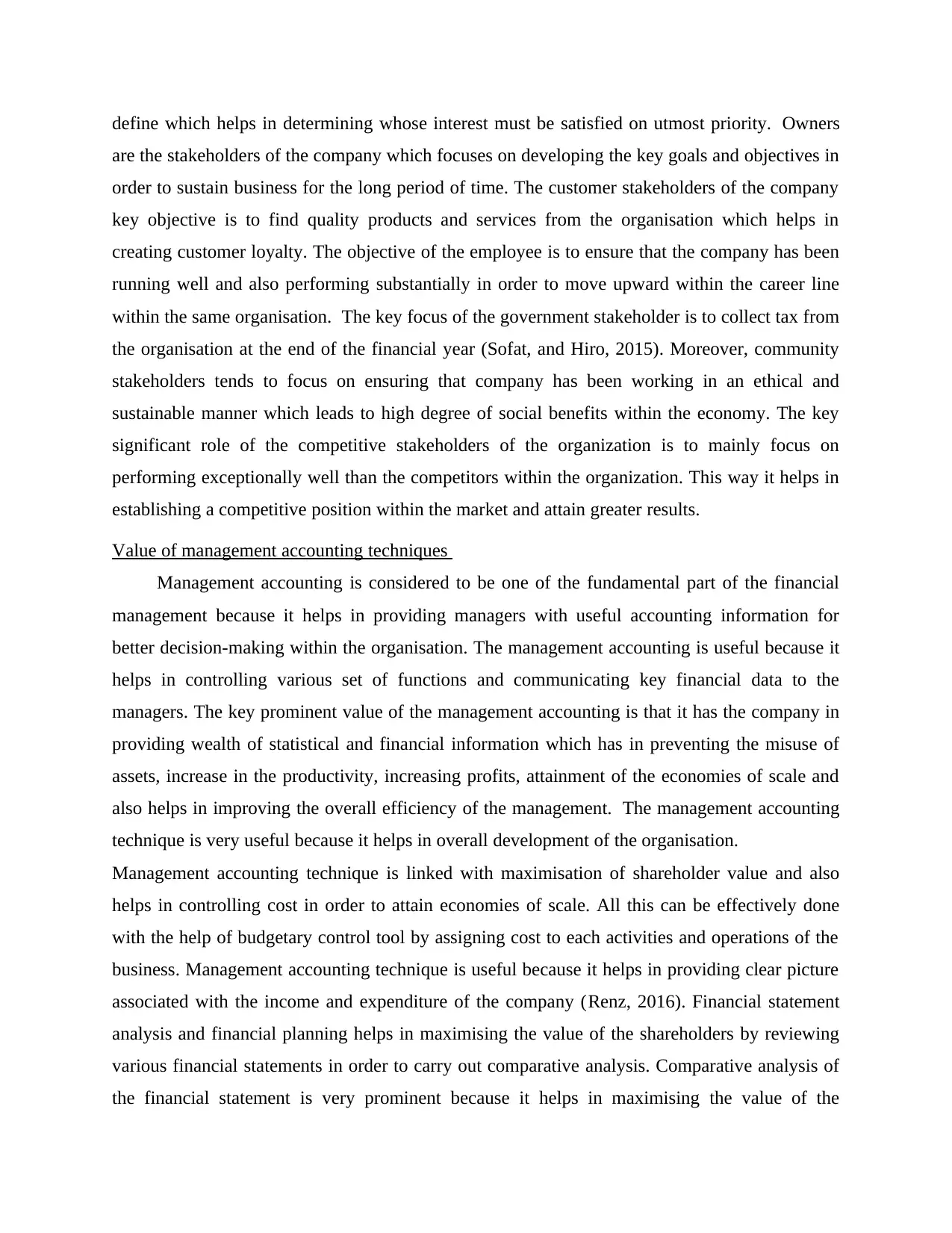
define which helps in determining whose interest must be satisfied on utmost priority. Owners
are the stakeholders of the company which focuses on developing the key goals and objectives in
order to sustain business for the long period of time. The customer stakeholders of the company
key objective is to find quality products and services from the organisation which helps in
creating customer loyalty. The objective of the employee is to ensure that the company has been
running well and also performing substantially in order to move upward within the career line
within the same organisation. The key focus of the government stakeholder is to collect tax from
the organisation at the end of the financial year (Sofat, and Hiro, 2015). Moreover, community
stakeholders tends to focus on ensuring that company has been working in an ethical and
sustainable manner which leads to high degree of social benefits within the economy. The key
significant role of the competitive stakeholders of the organization is to mainly focus on
performing exceptionally well than the competitors within the organization. This way it helps in
establishing a competitive position within the market and attain greater results.
Value of management accounting techniques
Management accounting is considered to be one of the fundamental part of the financial
management because it helps in providing managers with useful accounting information for
better decision-making within the organisation. The management accounting is useful because it
helps in controlling various set of functions and communicating key financial data to the
managers. The key prominent value of the management accounting is that it has the company in
providing wealth of statistical and financial information which has in preventing the misuse of
assets, increase in the productivity, increasing profits, attainment of the economies of scale and
also helps in improving the overall efficiency of the management. The management accounting
technique is very useful because it helps in overall development of the organisation.
Management accounting technique is linked with maximisation of shareholder value and also
helps in controlling cost in order to attain economies of scale. All this can be effectively done
with the help of budgetary control tool by assigning cost to each activities and operations of the
business. Management accounting technique is useful because it helps in providing clear picture
associated with the income and expenditure of the company (Renz, 2016). Financial statement
analysis and financial planning helps in maximising the value of the shareholders by reviewing
various financial statements in order to carry out comparative analysis. Comparative analysis of
the financial statement is very prominent because it helps in maximising the value of the
are the stakeholders of the company which focuses on developing the key goals and objectives in
order to sustain business for the long period of time. The customer stakeholders of the company
key objective is to find quality products and services from the organisation which helps in
creating customer loyalty. The objective of the employee is to ensure that the company has been
running well and also performing substantially in order to move upward within the career line
within the same organisation. The key focus of the government stakeholder is to collect tax from
the organisation at the end of the financial year (Sofat, and Hiro, 2015). Moreover, community
stakeholders tends to focus on ensuring that company has been working in an ethical and
sustainable manner which leads to high degree of social benefits within the economy. The key
significant role of the competitive stakeholders of the organization is to mainly focus on
performing exceptionally well than the competitors within the organization. This way it helps in
establishing a competitive position within the market and attain greater results.
Value of management accounting techniques
Management accounting is considered to be one of the fundamental part of the financial
management because it helps in providing managers with useful accounting information for
better decision-making within the organisation. The management accounting is useful because it
helps in controlling various set of functions and communicating key financial data to the
managers. The key prominent value of the management accounting is that it has the company in
providing wealth of statistical and financial information which has in preventing the misuse of
assets, increase in the productivity, increasing profits, attainment of the economies of scale and
also helps in improving the overall efficiency of the management. The management accounting
technique is very useful because it helps in overall development of the organisation.
Management accounting technique is linked with maximisation of shareholder value and also
helps in controlling cost in order to attain economies of scale. All this can be effectively done
with the help of budgetary control tool by assigning cost to each activities and operations of the
business. Management accounting technique is useful because it helps in providing clear picture
associated with the income and expenditure of the company (Renz, 2016). Financial statement
analysis and financial planning helps in maximising the value of the shareholders by reviewing
various financial statements in order to carry out comparative analysis. Comparative analysis of
the financial statement is very prominent because it helps in maximising the value of the
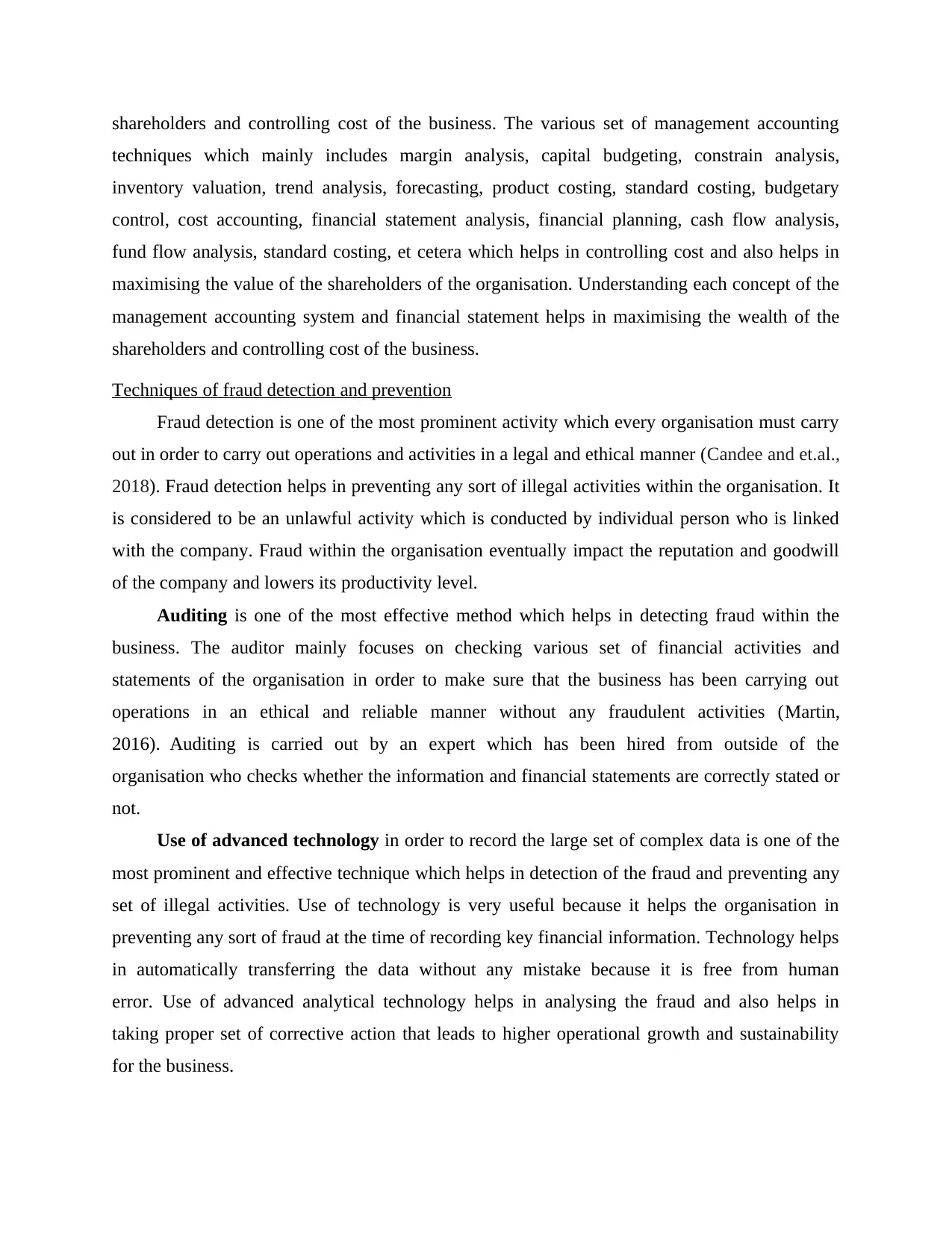
shareholders and controlling cost of the business. The various set of management accounting
techniques which mainly includes margin analysis, capital budgeting, constrain analysis,
inventory valuation, trend analysis, forecasting, product costing, standard costing, budgetary
control, cost accounting, financial statement analysis, financial planning, cash flow analysis,
fund flow analysis, standard costing, et cetera which helps in controlling cost and also helps in
maximising the value of the shareholders of the organisation. Understanding each concept of the
management accounting system and financial statement helps in maximising the wealth of the
shareholders and controlling cost of the business.
Techniques of fraud detection and prevention
Fraud detection is one of the most prominent activity which every organisation must carry
out in order to carry out operations and activities in a legal and ethical manner (Candee and et.al.,
2018). Fraud detection helps in preventing any sort of illegal activities within the organisation. It
is considered to be an unlawful activity which is conducted by individual person who is linked
with the company. Fraud within the organisation eventually impact the reputation and goodwill
of the company and lowers its productivity level.
Auditing is one of the most effective method which helps in detecting fraud within the
business. The auditor mainly focuses on checking various set of financial activities and
statements of the organisation in order to make sure that the business has been carrying out
operations in an ethical and reliable manner without any fraudulent activities (Martin,
2016). Auditing is carried out by an expert which has been hired from outside of the
organisation who checks whether the information and financial statements are correctly stated or
not.
Use of advanced technology in order to record the large set of complex data is one of the
most prominent and effective technique which helps in detection of the fraud and preventing any
set of illegal activities. Use of technology is very useful because it helps the organisation in
preventing any sort of fraud at the time of recording key financial information. Technology helps
in automatically transferring the data without any mistake because it is free from human
error. Use of advanced analytical technology helps in analysing the fraud and also helps in
taking proper set of corrective action that leads to higher operational growth and sustainability
for the business.
techniques which mainly includes margin analysis, capital budgeting, constrain analysis,
inventory valuation, trend analysis, forecasting, product costing, standard costing, budgetary
control, cost accounting, financial statement analysis, financial planning, cash flow analysis,
fund flow analysis, standard costing, et cetera which helps in controlling cost and also helps in
maximising the value of the shareholders of the organisation. Understanding each concept of the
management accounting system and financial statement helps in maximising the wealth of the
shareholders and controlling cost of the business.
Techniques of fraud detection and prevention
Fraud detection is one of the most prominent activity which every organisation must carry
out in order to carry out operations and activities in a legal and ethical manner (Candee and et.al.,
2018). Fraud detection helps in preventing any sort of illegal activities within the organisation. It
is considered to be an unlawful activity which is conducted by individual person who is linked
with the company. Fraud within the organisation eventually impact the reputation and goodwill
of the company and lowers its productivity level.
Auditing is one of the most effective method which helps in detecting fraud within the
business. The auditor mainly focuses on checking various set of financial activities and
statements of the organisation in order to make sure that the business has been carrying out
operations in an ethical and reliable manner without any fraudulent activities (Martin,
2016). Auditing is carried out by an expert which has been hired from outside of the
organisation who checks whether the information and financial statements are correctly stated or
not.
Use of advanced technology in order to record the large set of complex data is one of the
most prominent and effective technique which helps in detection of the fraud and preventing any
set of illegal activities. Use of technology is very useful because it helps the organisation in
preventing any sort of fraud at the time of recording key financial information. Technology helps
in automatically transferring the data without any mistake because it is free from human
error. Use of advanced analytical technology helps in analysing the fraud and also helps in
taking proper set of corrective action that leads to higher operational growth and sustainability
for the business.
⊘ This is a preview!⊘
Do you want full access?
Subscribe today to unlock all pages.

Trusted by 1+ million students worldwide
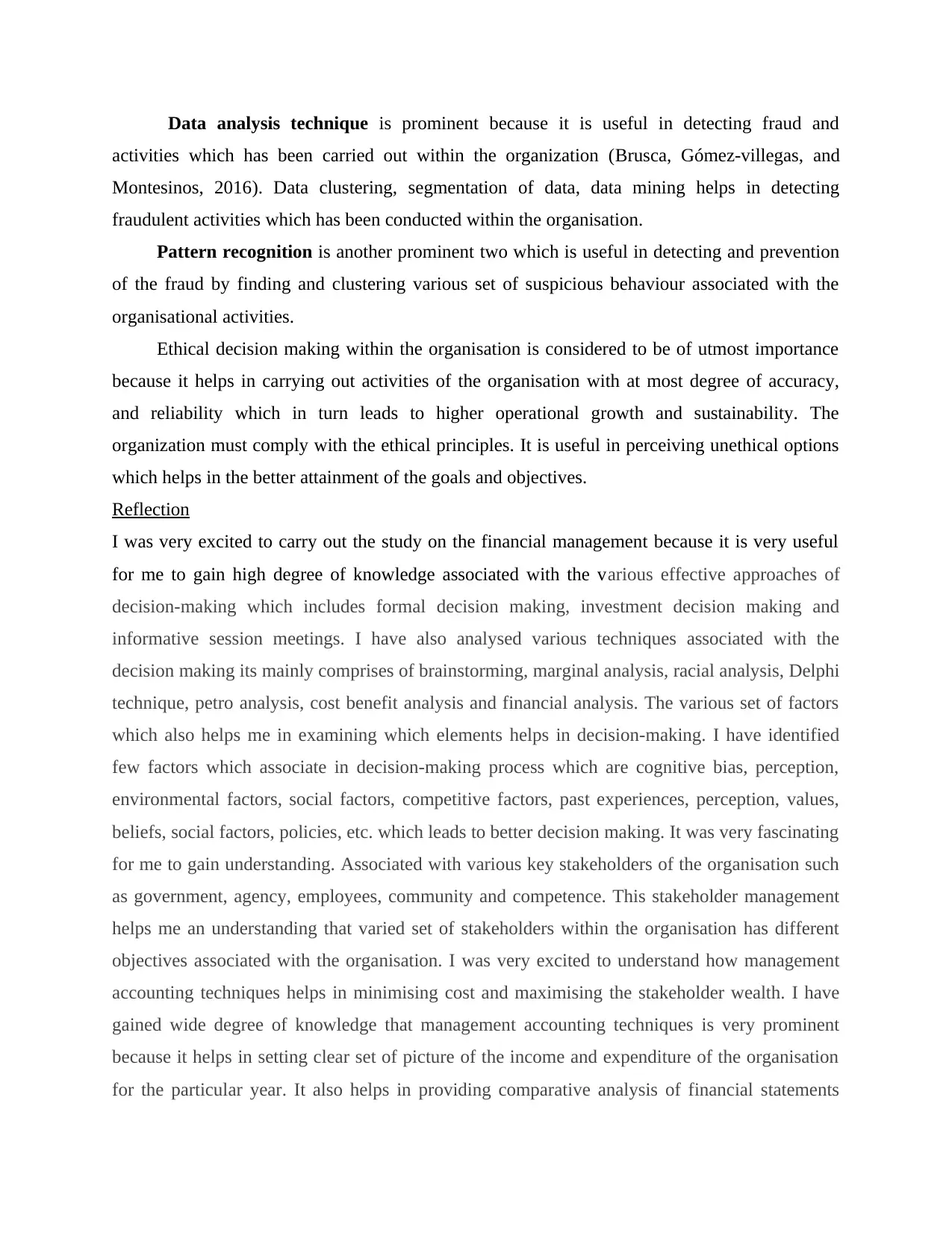
Data analysis technique is prominent because it is useful in detecting fraud and
activities which has been carried out within the organization (Brusca, Gómez‐villegas, and
Montesinos, 2016). Data clustering, segmentation of data, data mining helps in detecting
fraudulent activities which has been conducted within the organisation.
Pattern recognition is another prominent two which is useful in detecting and prevention
of the fraud by finding and clustering various set of suspicious behaviour associated with the
organisational activities.
Ethical decision making within the organisation is considered to be of utmost importance
because it helps in carrying out activities of the organisation with at most degree of accuracy,
and reliability which in turn leads to higher operational growth and sustainability. The
organization must comply with the ethical principles. It is useful in perceiving unethical options
which helps in the better attainment of the goals and objectives.
Reflection
I was very excited to carry out the study on the financial management because it is very useful
for me to gain high degree of knowledge associated with the various effective approaches of
decision-making which includes formal decision making, investment decision making and
informative session meetings. I have also analysed various techniques associated with the
decision making its mainly comprises of brainstorming, marginal analysis, racial analysis, Delphi
technique, petro analysis, cost benefit analysis and financial analysis. The various set of factors
which also helps me in examining which elements helps in decision-making. I have identified
few factors which associate in decision-making process which are cognitive bias, perception,
environmental factors, social factors, competitive factors, past experiences, perception, values,
beliefs, social factors, policies, etc. which leads to better decision making. It was very fascinating
for me to gain understanding. Associated with various key stakeholders of the organisation such
as government, agency, employees, community and competence. This stakeholder management
helps me an understanding that varied set of stakeholders within the organisation has different
objectives associated with the organisation. I was very excited to understand how management
accounting techniques helps in minimising cost and maximising the stakeholder wealth. I have
gained wide degree of knowledge that management accounting techniques is very prominent
because it helps in setting clear set of picture of the income and expenditure of the organisation
for the particular year. It also helps in providing comparative analysis of financial statements
activities which has been carried out within the organization (Brusca, Gómez‐villegas, and
Montesinos, 2016). Data clustering, segmentation of data, data mining helps in detecting
fraudulent activities which has been conducted within the organisation.
Pattern recognition is another prominent two which is useful in detecting and prevention
of the fraud by finding and clustering various set of suspicious behaviour associated with the
organisational activities.
Ethical decision making within the organisation is considered to be of utmost importance
because it helps in carrying out activities of the organisation with at most degree of accuracy,
and reliability which in turn leads to higher operational growth and sustainability. The
organization must comply with the ethical principles. It is useful in perceiving unethical options
which helps in the better attainment of the goals and objectives.
Reflection
I was very excited to carry out the study on the financial management because it is very useful
for me to gain high degree of knowledge associated with the various effective approaches of
decision-making which includes formal decision making, investment decision making and
informative session meetings. I have also analysed various techniques associated with the
decision making its mainly comprises of brainstorming, marginal analysis, racial analysis, Delphi
technique, petro analysis, cost benefit analysis and financial analysis. The various set of factors
which also helps me in examining which elements helps in decision-making. I have identified
few factors which associate in decision-making process which are cognitive bias, perception,
environmental factors, social factors, competitive factors, past experiences, perception, values,
beliefs, social factors, policies, etc. which leads to better decision making. It was very fascinating
for me to gain understanding. Associated with various key stakeholders of the organisation such
as government, agency, employees, community and competence. This stakeholder management
helps me an understanding that varied set of stakeholders within the organisation has different
objectives associated with the organisation. I was very excited to understand how management
accounting techniques helps in minimising cost and maximising the stakeholder wealth. I have
gained wide degree of knowledge that management accounting techniques is very prominent
because it helps in setting clear set of picture of the income and expenditure of the organisation
for the particular year. It also helps in providing comparative analysis of financial statements
Paraphrase This Document
Need a fresh take? Get an instant paraphrase of this document with our AI Paraphraser
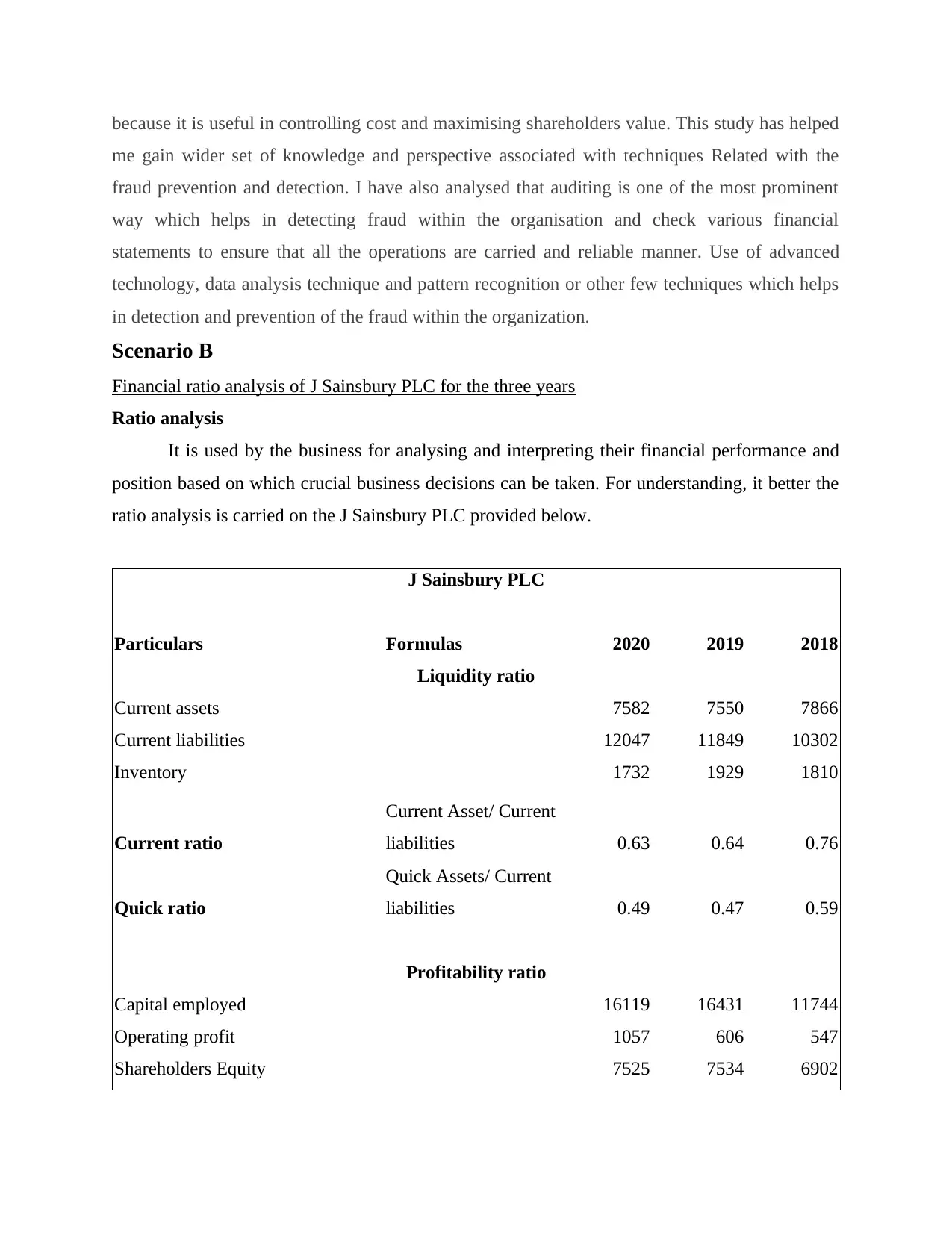
because it is useful in controlling cost and maximising shareholders value. This study has helped
me gain wider set of knowledge and perspective associated with techniques Related with the
fraud prevention and detection. I have also analysed that auditing is one of the most prominent
way which helps in detecting fraud within the organisation and check various financial
statements to ensure that all the operations are carried and reliable manner. Use of advanced
technology, data analysis technique and pattern recognition or other few techniques which helps
in detection and prevention of the fraud within the organization.
Scenario B
Financial ratio analysis of J Sainsbury PLC for the three years
Ratio analysis
It is used by the business for analysing and interpreting their financial performance and
position based on which crucial business decisions can be taken. For understanding, it better the
ratio analysis is carried on the J Sainsbury PLC provided below.
J Sainsbury PLC
Particulars Formulas 2020 2019 2018
Liquidity ratio
Current assets 7582 7550 7866
Current liabilities 12047 11849 10302
Inventory 1732 1929 1810
Current ratio
Current Asset/ Current
liabilities 0.63 0.64 0.76
Quick ratio
Quick Assets/ Current
liabilities 0.49 0.47 0.59
Profitability ratio
Capital employed 16119 16431 11744
Operating profit 1057 606 547
Shareholders Equity 7525 7534 6902
me gain wider set of knowledge and perspective associated with techniques Related with the
fraud prevention and detection. I have also analysed that auditing is one of the most prominent
way which helps in detecting fraud within the organisation and check various financial
statements to ensure that all the operations are carried and reliable manner. Use of advanced
technology, data analysis technique and pattern recognition or other few techniques which helps
in detection and prevention of the fraud within the organization.
Scenario B
Financial ratio analysis of J Sainsbury PLC for the three years
Ratio analysis
It is used by the business for analysing and interpreting their financial performance and
position based on which crucial business decisions can be taken. For understanding, it better the
ratio analysis is carried on the J Sainsbury PLC provided below.
J Sainsbury PLC
Particulars Formulas 2020 2019 2018
Liquidity ratio
Current assets 7582 7550 7866
Current liabilities 12047 11849 10302
Inventory 1732 1929 1810
Current ratio
Current Asset/ Current
liabilities 0.63 0.64 0.76
Quick ratio
Quick Assets/ Current
liabilities 0.49 0.47 0.59
Profitability ratio
Capital employed 16119 16431 11744
Operating profit 1057 606 547
Shareholders Equity 7525 7534 6902
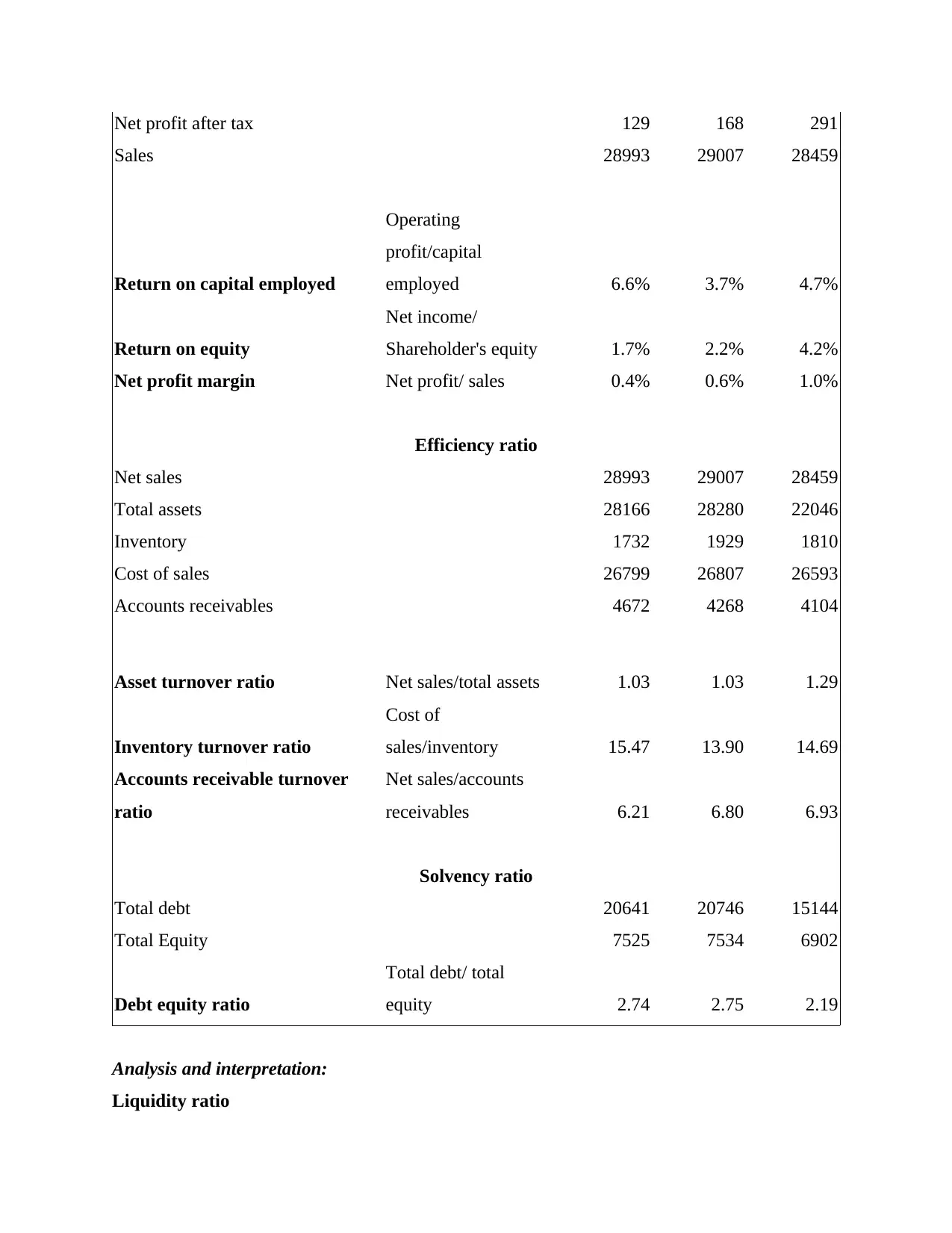
Net profit after tax 129 168 291
Sales 28993 29007 28459
Return on capital employed
Operating
profit/capital
employed 6.6% 3.7% 4.7%
Return on equity
Net income/
Shareholder's equity 1.7% 2.2% 4.2%
Net profit margin Net profit/ sales 0.4% 0.6% 1.0%
Efficiency ratio
Net sales 28993 29007 28459
Total assets 28166 28280 22046
Inventory 1732 1929 1810
Cost of sales 26799 26807 26593
Accounts receivables 4672 4268 4104
Asset turnover ratio Net sales/total assets 1.03 1.03 1.29
Inventory turnover ratio
Cost of
sales/inventory 15.47 13.90 14.69
Accounts receivable turnover
ratio
Net sales/accounts
receivables 6.21 6.80 6.93
Solvency ratio
Total debt 20641 20746 15144
Total Equity 7525 7534 6902
Debt equity ratio
Total debt/ total
equity 2.74 2.75 2.19
Analysis and interpretation:
Liquidity ratio
Sales 28993 29007 28459
Return on capital employed
Operating
profit/capital
employed 6.6% 3.7% 4.7%
Return on equity
Net income/
Shareholder's equity 1.7% 2.2% 4.2%
Net profit margin Net profit/ sales 0.4% 0.6% 1.0%
Efficiency ratio
Net sales 28993 29007 28459
Total assets 28166 28280 22046
Inventory 1732 1929 1810
Cost of sales 26799 26807 26593
Accounts receivables 4672 4268 4104
Asset turnover ratio Net sales/total assets 1.03 1.03 1.29
Inventory turnover ratio
Cost of
sales/inventory 15.47 13.90 14.69
Accounts receivable turnover
ratio
Net sales/accounts
receivables 6.21 6.80 6.93
Solvency ratio
Total debt 20641 20746 15144
Total Equity 7525 7534 6902
Debt equity ratio
Total debt/ total
equity 2.74 2.75 2.19
Analysis and interpretation:
Liquidity ratio
⊘ This is a preview!⊘
Do you want full access?
Subscribe today to unlock all pages.

Trusted by 1+ million students worldwide
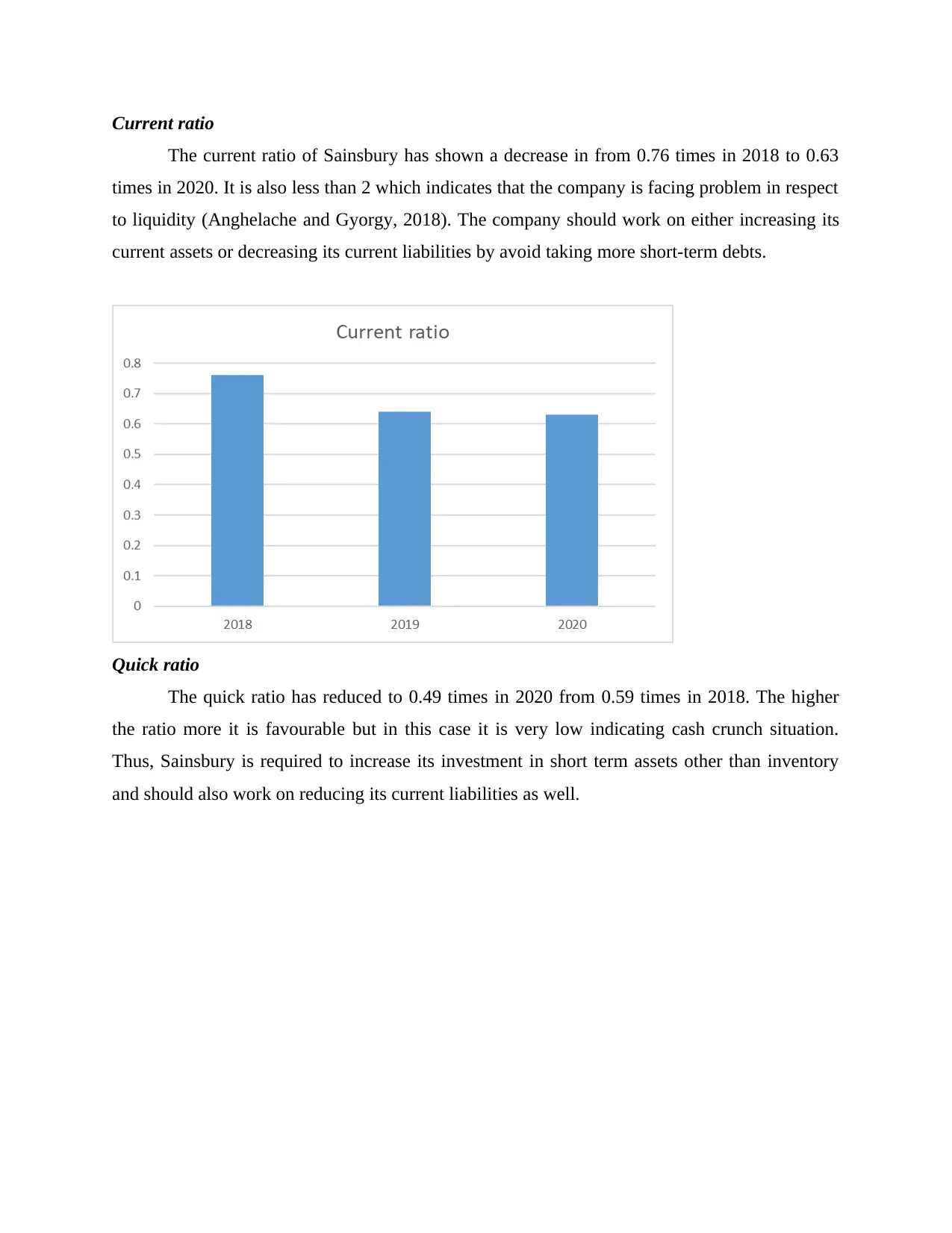
Current ratio
The current ratio of Sainsbury has shown a decrease in from 0.76 times in 2018 to 0.63
times in 2020. It is also less than 2 which indicates that the company is facing problem in respect
to liquidity (Anghelache and Gyorgy, 2018). The company should work on either increasing its
current assets or decreasing its current liabilities by avoid taking more short-term debts.
Quick ratio
The quick ratio has reduced to 0.49 times in 2020 from 0.59 times in 2018. The higher
the ratio more it is favourable but in this case it is very low indicating cash crunch situation.
Thus, Sainsbury is required to increase its investment in short term assets other than inventory
and should also work on reducing its current liabilities as well.
The current ratio of Sainsbury has shown a decrease in from 0.76 times in 2018 to 0.63
times in 2020. It is also less than 2 which indicates that the company is facing problem in respect
to liquidity (Anghelache and Gyorgy, 2018). The company should work on either increasing its
current assets or decreasing its current liabilities by avoid taking more short-term debts.
Quick ratio
The quick ratio has reduced to 0.49 times in 2020 from 0.59 times in 2018. The higher
the ratio more it is favourable but in this case it is very low indicating cash crunch situation.
Thus, Sainsbury is required to increase its investment in short term assets other than inventory
and should also work on reducing its current liabilities as well.
Paraphrase This Document
Need a fresh take? Get an instant paraphrase of this document with our AI Paraphraser
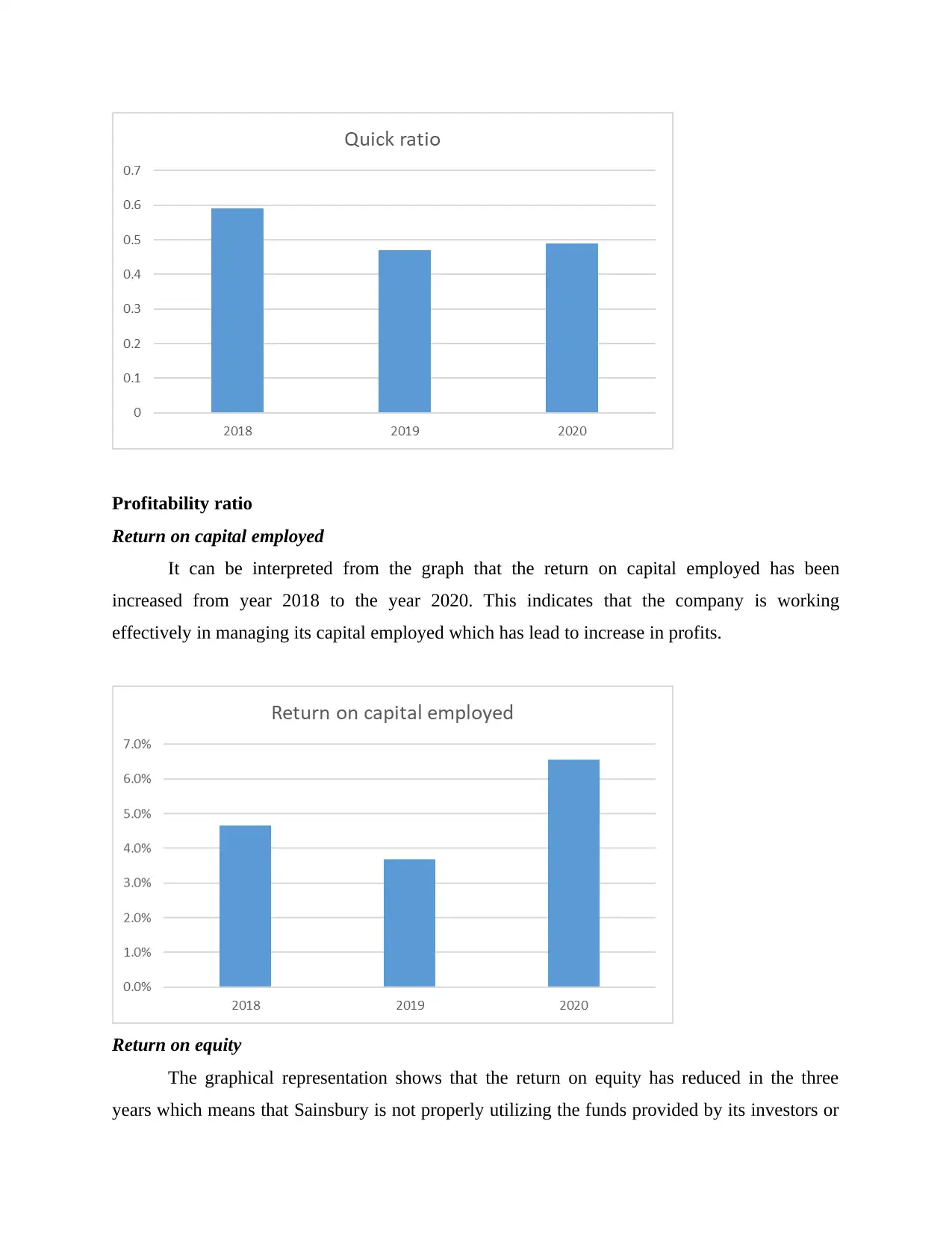
Profitability ratio
Return on capital employed
It can be interpreted from the graph that the return on capital employed has been
increased from year 2018 to the year 2020. This indicates that the company is working
effectively in managing its capital employed which has lead to increase in profits.
Return on equity
The graphical representation shows that the return on equity has reduced in the three
years which means that Sainsbury is not properly utilizing the funds provided by its investors or
Return on capital employed
It can be interpreted from the graph that the return on capital employed has been
increased from year 2018 to the year 2020. This indicates that the company is working
effectively in managing its capital employed which has lead to increase in profits.
Return on equity
The graphical representation shows that the return on equity has reduced in the three
years which means that Sainsbury is not properly utilizing the funds provided by its investors or
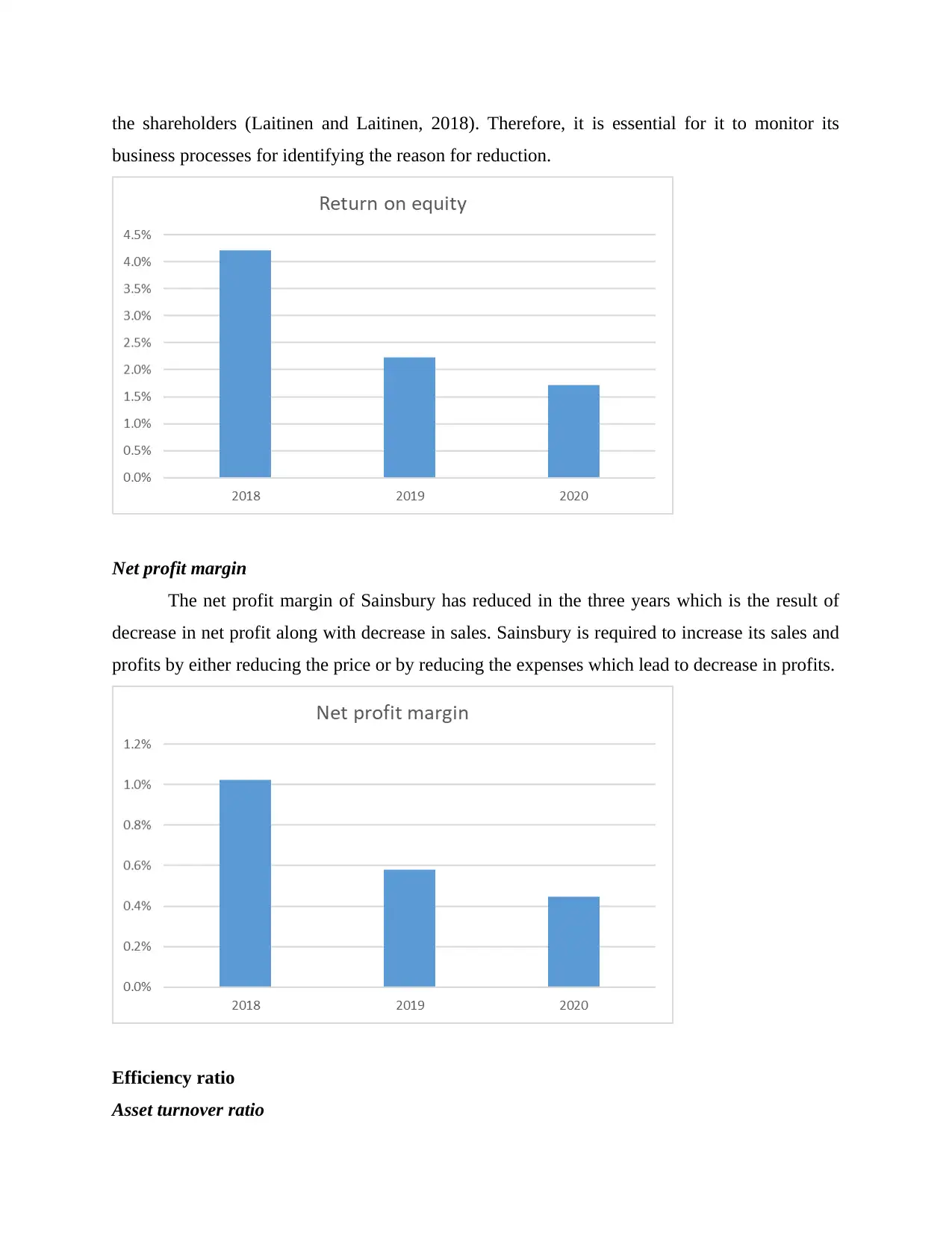
the shareholders (Laitinen and Laitinen, 2018). Therefore, it is essential for it to monitor its
business processes for identifying the reason for reduction.
Net profit margin
The net profit margin of Sainsbury has reduced in the three years which is the result of
decrease in net profit along with decrease in sales. Sainsbury is required to increase its sales and
profits by either reducing the price or by reducing the expenses which lead to decrease in profits.
Efficiency ratio
Asset turnover ratio
business processes for identifying the reason for reduction.
Net profit margin
The net profit margin of Sainsbury has reduced in the three years which is the result of
decrease in net profit along with decrease in sales. Sainsbury is required to increase its sales and
profits by either reducing the price or by reducing the expenses which lead to decrease in profits.
Efficiency ratio
Asset turnover ratio
⊘ This is a preview!⊘
Do you want full access?
Subscribe today to unlock all pages.

Trusted by 1+ million students worldwide
1 out of 19
Related Documents
Your All-in-One AI-Powered Toolkit for Academic Success.
+13062052269
info@desklib.com
Available 24*7 on WhatsApp / Email
![[object Object]](/_next/static/media/star-bottom.7253800d.svg)
Unlock your academic potential
Copyright © 2020–2025 A2Z Services. All Rights Reserved. Developed and managed by ZUCOL.





